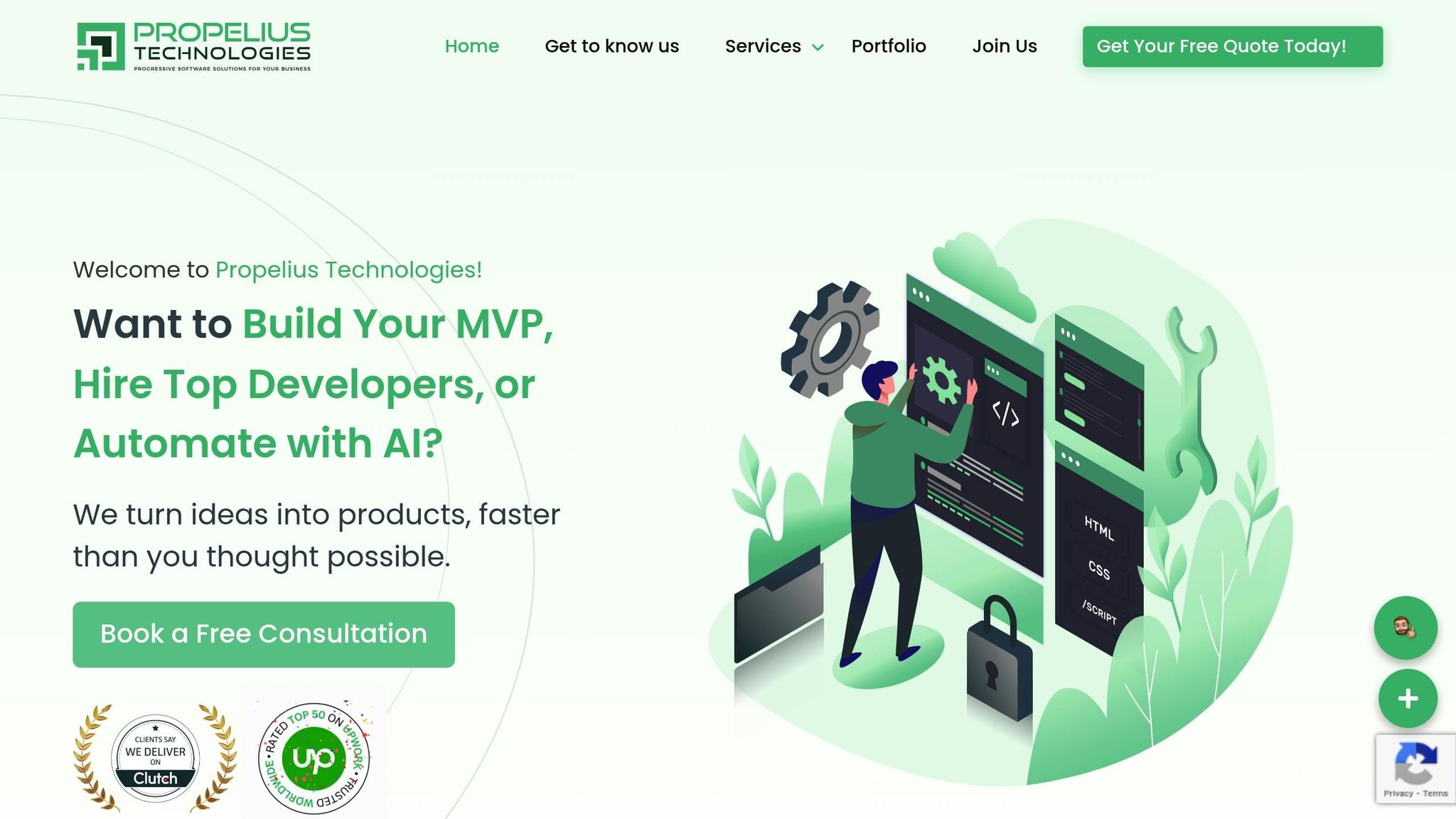
Tenant Data Isolation: Patterns and Anti-Patterns
Explore effective patterns and pitfalls of tenant data isolation in multi-tenant systems to enhance security and compliance.
Jul 30, 2025
Read More
Want to build your product faster and smarter? Agile sprints can help you develop a Minimum Viable Product (MVP) quickly, test it with users, and adapt based on feedback - all without wasting time or money. Here's what you need to know:
Agile sprints bring a unique edge to developing MVPs, offering startups a structured yet flexible way to iterate and improve quickly. These benefits are backed by data and real-world examples, making Agile an ideal choice for fast-paced product development.
Agile sprints speed up development by breaking the process into smaller, manageable chunks. Instead of waiting for the entire product to be completed, features are rolled out incrementally every few weeks. This means your MVP reaches users sooner, giving you that all-important first-mover advantage.
Organizations using Agile report a 20% boost in project success rates, and integrated teams complete projects 30% faster compared to traditional methods.
As Karl L. Hughes, an Engineering Manager, explains:
"Agile is great for startups who need to build software at a predictable pace while remaining flexible enough to change the product frequently."
This steady pace is invaluable for startups, especially when time and resources are limited. Each sprint results in functional software, ready to be tested, validated, and refined - creating a cycle of constant progress.
Startups often face shifting market demands and user needs, making flexibility a must. Agile sprints are built to accommodate these changes without derailing the entire project. According to the 2024 State of Agile report, 63% of development teams highlight managing changing priorities as a core reason for adopting Agile.
Sprint reviews provide a natural checkpoint to reassess and adjust. If user feedback suggests a pivot, the next sprint can reflect that change without disrupting the larger project.
Agile teams are also 25% more productive than their industry counterparts. This adaptability ensures that when priorities shift - and they inevitably will - teams can address challenges quickly and keep moving forward.
Agile thrives on continuous feedback, ensuring the product evolves based on what users actually need. Companies that actively engage with user input are 60% more likely to succeed in their market segment.
Take Spotify, for example. Its early technical prototype validated the streaming concept, which helped secure essential support. Similarly, the Swedish Police tested a small system in 2010 with limited users and functionality. Feedback from this trial guided improvements, eventually expanding the system’s scope and effectiveness.
Getting Agile sprints right takes careful planning, smart prioritization, and a well-rounded team. When these pieces come together, they create a structured and efficient development process. This setup helps ensure that your Minimum Viable Product (MVP) goals are not just met but exceeded.
Every sprint should have a specific purpose that ties directly to your larger business goals. Clear goals don’t just keep tasks organized - they also help teams navigate unexpected challenges. The best sprint goals follow the SMART framework: they’re specific, measurable, achievable, relevant, and time-bound. Instead of vague targets, focus on measurable outcomes that align with your business objectives. Once those goals are in place, break down user stories into smaller, manageable tasks to keep the development process running smoothly.
When it comes to your MVP, the features you choose can make all the difference. The focus should always be on core functionalities that support your product’s purpose and validate your business assumptions. This means prioritizing features that add real user value over those that don’t contribute much to learning or impact.
Start by defining what success looks like for your MVP and understanding your audience’s needs. Tools like the MoSCoW method, user story mapping, and priority matrices can help you rank features based on their importance and the effort required. For example, Dropbox initially showcased its file-syncing concept with a simple demo video, while Airbnb tested its idea with a basic setup before scaling. Regular feedback from users ensures your priorities stay aligned with their needs.
A great MVP isn’t just about ideas; it’s about execution - and that requires a skilled, well-rounded team. Cross-functional teams bring together technical expertise, design thinking, product strategy, and quality assurance, which helps streamline development and avoid delays. Key roles include:
Smaller teams, typically with 5–7 members, are ideal for staying agile and making quick decisions. The right mix of technical know-how and a collaborative mindset is essential for adapting to new insights and keeping the project on course.
Once your team structure is in place, certain Agile practices can help streamline workflows, shorten development cycles, and maintain product quality. These methods ensure teams stay focused and aligned on priorities while fostering continuous improvement.
Daily stand-ups, kept to just 15 minutes, are a cornerstone of Agile practices. They help teams stay focused and quickly identify issues. During these meetings, team members answer three key questions: What did you work on yesterday? What will you work on today? Are there any roadblocks? This simple structure keeps discussions targeted and avoids wasting time. Research shows that unproductive meetings cost organizations billions each year, while teams using the Scrum framework can achieve outputs up to 250× higher in quality compared to traditional methods.
The secret to effective stand-ups is to keep them brief and energetic - literally standing up helps. Detailed problem-solving should be handled in separate sessions to avoid derailing the meeting’s purpose. By quickly identifying obstacles, teams can address them promptly and keep progress on track.
Once daily updates are running smoothly, teams can take efficiency a step further with automation.
Automation is a game-changer for speeding up development cycles. Automated testing provides faster feedback, thorough test coverage, and more consistent defect detection. It also minimizes human error and ensures higher software quality. For example, in Q4 2023, San Diego Superior Court managed to reduce testing time and staffing needs by 40% through test automation. Jake Pison, CIO at San Diego Superior Court, highlighted the broader benefits:
"Our objective is to accumulate significant efficiency gains overall by automating these simple, repetitive tasks across various departments within the organization."
Admincontrol offers another success story. Their automated testing runs over 2,000 tests weekly, freeing up team members to focus on more complex tasks. Vegar Warhuus, Software Testing Team Lead at Admincontrol, shared:
"We have more time for test disciplines that require high technical skills and test analysis capacities."
When introducing test automation, start by focusing on critical paths - those areas where failures would most impact your users or business. Build automation incrementally, prioritizing high-value tests first, and regularly review your processes to ensure they stay relevant.
With automation in place, sprint reviews can further refine the development process.
Sprint reviews are essential for keeping your MVP aligned with market demands. These sessions allow teams to showcase completed work, gather stakeholder feedback, and ensure the product remains on track with its vision and goals. Unlike retrospectives, which focus on team processes, sprint reviews evaluate the product itself and its direction. Scheduling these reviews as the second-to-last event in each sprint ensures feedback can be quickly incorporated into the next sprint planning session.
Mark Cruth, Modern Work Coach at Atlassian, advocates for involving the entire team during these reviews:
"Encourage team ownership during the sprint review by having different team members demonstrate the functionality. If you use Feature Leads, this is a great way for them to demonstrate their hard work leading the effort."
To maximize engagement, create a stakeholder map before each review. Identify key players, their interests, and their availability to ensure meaningful participation. This approach validates progress, highlights areas for improvement, and keeps the product responsive to user needs.
Even with strong Agile practices in place, startups often face hurdles that can throw MVP development off track. Addressing these challenges head-on is just as important as making steady progress through sprints. How these issues are managed can ultimately determine whether a project launches successfully or grinds to a halt.
One of the biggest threats to an MVP's success is scope creep. Pete Peranzo, Co-founder of Imaginovation, puts it plainly:
"I think, every single technology project has scope creep. I'd say 99.99% of projects have scope creep."
Scope creep happens when stakeholders keep adding new features, causing delays and inflating costs. What starts as a lean, streamlined MVP can quickly balloon into an overly complex product that takes far longer - and costs far more - to build than originally planned.
To combat this, try using the MoSCoW Method, which categorizes features into Must-Have, Should-Have, Could-Have, and Won't-Have groups. Keep your focus strictly on the Must-Have features, and implement a Feature Freeze policy to defer non-essential ideas to a "Phase 2 Backlog". Introducing a formal change request process also helps, requiring stakeholders to justify why a new feature is critical to the MVP's core purpose.
As Peranzo stresses:
"You have to establish that and stay firm on it, or you're going to get rolled over."
Additionally, set aside a contingency buffer - 10–20% of your budget and 10–15% extra time in your project schedule - to handle unforeseen changes without derailing the timeline.
By keeping scope in check, your team can stay focused on fast, efficient development.
Agile sprints are all about speed, but maintaining quality is just as crucial. The good news? Speed and quality can coexist if you build quality checks into your process from the very beginning.
Here’s how: adopt test-driven development, use automated testing for repetitive tasks, and implement continuous integration to identify and fix issues early. Clearly defined acceptance criteria for every user story - outlining exactly what "done" means - can prevent miscommunication and ensure consistent quality throughout the project. Regular user feedback sessions are another key tool, helping you catch usability issues early and confirm that your MVP addresses real needs.
Documenting and enforcing uniform standards - whether for coding, testing, or peer reviews - ensures quality across the board.
Misaligned stakeholders can derail an MVP project faster than any technical issue. When investors, advisors, team members, and customers have conflicting expectations, confusion and disagreements can quickly follow.
The solution? Involve stakeholders early in the planning phase to clarify their goals, concerns, and success metrics. Assign clear decision-makers for key areas like product features, technical approaches, and timeline adjustments. A solid communication plan can also help address common questions such as: When will the first working version be ready? How will success be measured? What happens if we need to pivot? Addressing these concerns upfront builds trust and reduces uncertainty.
Sprint reviews are another effective tool. By showcasing progress and gathering feedback at regular intervals, you can ensure alignment on the product's direction. That said, be cautious about involving too many voices in every decision. As Peranzo warns:
"When we involve way too many voices, then it ends up complicating decision-making."
Transparent communication about challenges and changes keeps everyone informed and better equipped to handle setbacks. This clarity and openness can go a long way in keeping your MVP project on track.
When it comes to building a Minimum Viable Product (MVP), Agile sprints can be your secret weapon. This approach replaces the traditional, often sluggish development process with a system that thrives on feedback and adaptability, helping you get to market faster and more confidently.
Statistics show that startups using Agile development to create their MVPs enjoy a 70% success rate. That’s not just a number - it’s a clear indicator of how effective this method can be.
As Karl L. Hughes, an experienced Engineering Manager, puts it:
"Agile is great for startups who need to build software at a predictable pace while remaining flexible enough to change the product frequently."
By keeping these principles in mind, startups can significantly improve their chances of success.

If you’re looking to leverage Agile sprints effectively, Propelius Technologies is a partner that understands the unique challenges startups face. We offer a 90-day MVP sprint designed to embody Agile principles like speed, adaptability, and continuous feedback.
Here’s what sets us apart:
In just 90 days, our Agile-driven process can turn your vision into a market-ready reality. By partnering with Propelius Technologies, you’ll be equipped with the tools, expertise, and support to bring your MVP to life - quickly and effectively.
Agile sprints are a great way to keep scope creep in check during the development of a Minimum Viable Product (MVP). By dividing the work into short, focused cycles, teams can concentrate on delivering specific, high-priority features within a set period. This approach keeps everyone on the same page with clear objectives, reducing the chances of unplanned features sneaking in and throwing off timelines or budgets.
Regular sprint reviews and ongoing feedback from stakeholders make it easier to make intentional, controlled changes to the scope when needed. With a well-organized product backlog and a focus on prioritizing features that bring the most business value, Agile teams ensure they tackle the most important functionalities first. This keeps the project streamlined and on track.
Maintaining product quality during Agile sprints calls for a thoughtful and consistent approach. One of the best ways to achieve this is by bringing Quality Assurance (QA) into the picture early in the development process. When QA is involved from the start, testing and feedback become an ongoing part of each sprint. This method, often referred to as "shift-left testing", ensures that quality checks are integrated at every stage, helping teams catch and resolve issues before they grow into bigger problems.
Another key strategy is implementing Continuous Integration and Continuous Delivery (CI/CD) practices. These methods automate testing and deployment, making it easier to spot and fix bugs quickly while keeping quality intact. Regular code reviews and sprint retrospectives also contribute significantly by encouraging collaboration and fostering a mindset of continuous improvement among team members. By blending these approaches, Agile teams can roll out MVPs swiftly without sacrificing the quality users expect.
Agile keeps a Minimum Viable Product (MVP) in tune with user needs and shifting market trends through its iterative development process and continuous feedback loops. By working in short, focused sprints, teams can test features quickly, gather real-world feedback from users, and make adjustments as needed to refine the product. This flexibility ensures the MVP evolves in response to actual user demands, staying relevant even in fast-changing markets.
On top of that, Agile promotes collaboration among cross-functional teams, creating a stronger understanding of what users expect. This teamwork helps prioritize features that provide the most value, ensuring the MVP is both practical and effective right from the start.
Need an expert team to provide digital solutions for your business?
Book A Free CallDive into a wealth of knowledge with our unique articles and resources. Stay informed about the latest trends and best practices in the tech industry.
View All articlesGet in Touch
Let's Make It Happen
Get Your Free Quote Today!

Get in Touch
Let's Make It Happen
Get Your Free Quote Today!

